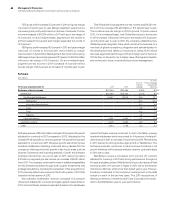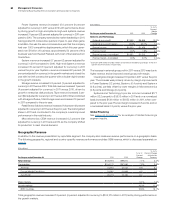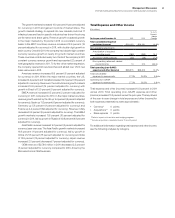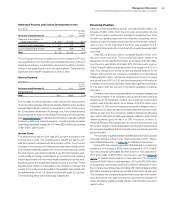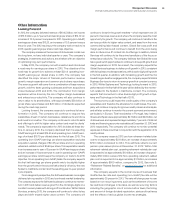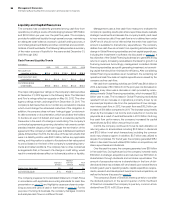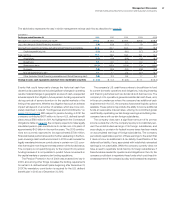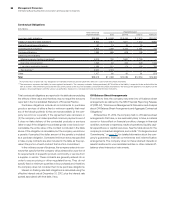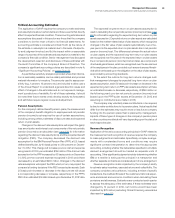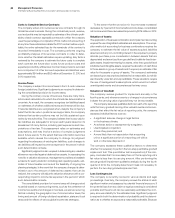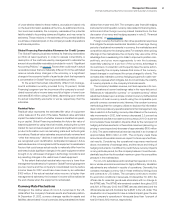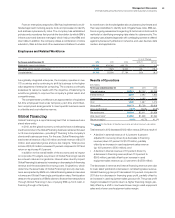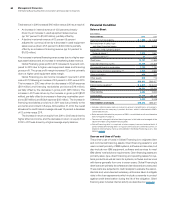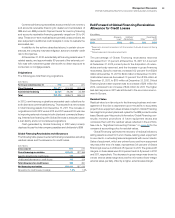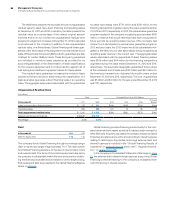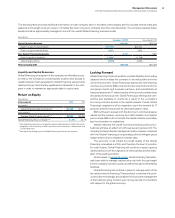IBM 2012 Annual Report Download - page 58
Download and view the complete annual report
Please find page 58 of the 2012 IBM annual report below. You can navigate through the pages in the report by either clicking on the pages listed below, or by using the keyword search tool below to find specific information within the annual report.
57
Management Discussion
International Business Machines Corporation and Subsidiary Companies
The table below represents the way in which management reviews cash flow as described on page 56.
($ in billions)
For the year ended December 31: 2012 2011 2010 2009 2008
Net cash from operating activities per GAAP $ 19.6 $ 19.8 $ 19.5 $20.8 $ 18.8
Less: the change in Global Financing receivables (2.9) (0.8) (0.7) 1.9 (0.0)
Net cash from operating activities, excluding Global Financing receivables 22.5 20.7 20.3 18.9 18.8
Capital expenditures, net (4.3) (4.1) (4.0) (3.7)(4.5)
Free cash flow 18.2 16.6 16.3 15.1 14.3
Acquisitions (3.7) (1.8) (5.9) (1.2)(6.3)
Divestitures 0.6 0.0 0.1 0.4 0.1
Share repurchase (12.0) (15.0) (15.4) (7.4)(10.6)
Dividends (3.8) (3.5) (3.2) (2.9) (2.6)
Non-Global Financing debt 0.7 1.7 2.3 (4.7)(3.2)
Other (includes Global Financing receivables and Global Financing debt) (0.8) 2.3 3.5 1.7 5.0
Change in cash, cash equivalents and short-term marketable securities $ (0.8) $ 0.3 $ (2.3)$ 1.1 $ (3.2)
Events that could temporarily change the historical cash flow
dynamics discussed above include significant changes in operating
results, material changes in geographic sources of cash, unexpected
adverse impacts from litigation, future pension funding requirements
during periods of severe downturn in the capital markets or the
timing of tax payments. Whether any litigation has such an adverse
impact will depend on a number of variables, which are more com-
pletely described in note M, “Contingencies and Commitments,” on
pages 110 through 112. With respect to pension funding, in 2012, the
company contributed $617 million to its non-U.S. defined benefit
plans versus $798 million in 2011. As highlighted in the Contractual
Obligations table on page 58, the company expects to make legally
mandated pension plan contributions to certain non-U.S. plans of
approximately $4.0 billion in the next five years. The 2013 contribu-
tions are currently expected to be approximately $700 million.
Financial market performance and/or further weakening in the Euro-
pean sovereign debt credit environment in 2013 could increase the
legally mandated minimum contributions in certain non-U.S. coun-
tries that require more frequent remeasurement of the funded status.
The company is not quantifying any further impact from pension
funding because it is not possible to predict future movements in
the capital markets or pension plan funding regulations.
The Pension Protection Act of 2006 was enacted into law in
2006, and, among other things, increases the funding requirements
for certain U.S. defined benefit plans beginning after December 31,
2007. No mandatory contribution is required for the U.S. defined
benefit plan in 2013 as of December 31, 2012.
The company’s U.S. cash flows continue to be sufficient to fund
its current domestic operations and obligations, including investing
and financing activities such as dividends and debt service. The
company’s U.S. operations generate substantial cash flows, and,
in those circumstances where the company has additional cash
requirements in the U.S., the company has several liquidity options
available. These options may include the ability to borrow additional
funds at reasonable interest rates, utilizing its committed global
credit facility, repatriating certain foreign earnings and utilizing inter-
company loans with certain foreign subsidiaries.
The company does earn a significant amount of its pre-tax
income outside the U.S. The company’s policy is to indefinitely rein-
vest the undistributed earnings of its foreign subsidiaries, and
accordingly, no provision for federal income taxes has been made
on accumulated earnings of foreign subsidiaries. The company
periodically repatriates a portion of these earnings to the extent that
it does not incur an additional U.S. tax liability. Quantification of the
deferred tax liability, if any, associated with indefinitely reinvested
earnings is not practicable. While the company currently does not
have a need to repatriate funds held by its foreign subsidiaries, if
these funds are needed for operations and obligations in the U.S., the
company could elect to repatriate these funds which could result in
a reassessment of the company’s policy and increased tax expense.



